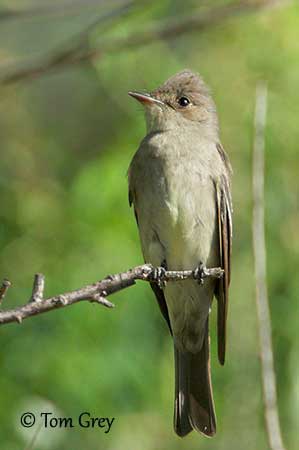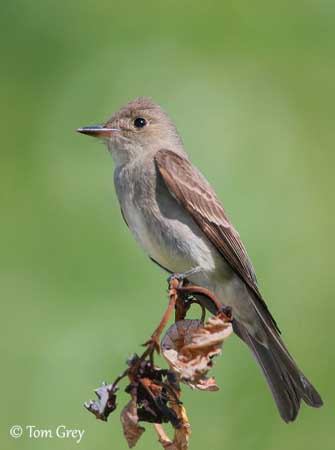
Fr: Pioui de l'Ouest
Ang: Western Wood-Pewee
All: Westlicher Waldschnäppertyrann
Esp: Pibí Occidental
Ita: Piuì boschereccio occidentale
Nd: Westelijke Bospiewie
Sd: västlig pivi
Photographers:
Roger Ahlman
Pbase Galleries Peru and Ecuador
Tom Grey
Tom Grey's Bird Pictures & Tom Grey's Bird Pictures 2
Tom Merigan
Tom Merigan’s Photo Galleries
Text by Nicole Bouglouan
Sources:
HANDBOOK OF THE BIRDS OF THE WORLD Vol 9 - by Josep del Hoyo - Andrew Elliot - David Christie - Lynx Edicions - ISBN: 8487334695
BIRDS OF THE GREAT BASIN – by Fred A. Ryser, Jr - University of Nevada Press -ISBN: 0874170796
FIELD GUIDE TO THE BIRDS OF NORTH AMERICA - National Geographic Society - ISBN: 0792274512
Animal Diversity Web (University of Michigan Museum of Zoology)
Bird Web (Seattle Audubon Society)
South Dakota Birds and Birding – (Terry L. Sohl)
What Bird-The ultimate Bird Guide (Mitchell Waite)
Wikipedia, the free encyclopaedia

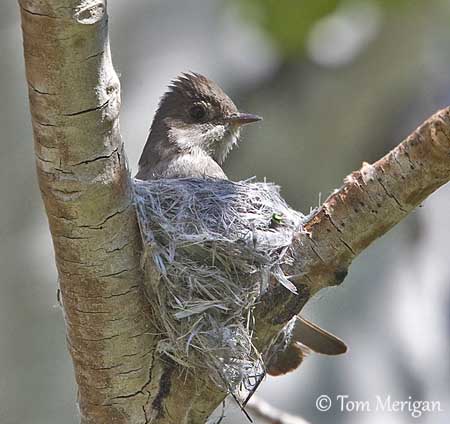
Western Wood-Pewee
Contopus sordidulus
Passeriformes Order – Tyrannidae Family
INTRODUCTION:
The Western Wood-Pewee is closely related to the Eastern Wood-Pewee (C. virens), but they have different ranges with small areas of overlap, and they differ by their vocalizations.
The Western Wood-Pewee breeds in W North America, from S Alaska to Mexico, and it spends the winter in Central America, as far as Panama.
When its habitat is mentioned, it is often said that this species “occurs wherever there are trees” and it is not tied to any particular type of tree. However, during winter, it also frequents cultivated areas, meadows, grasslands, and thickets.
It feeds mainly on insects of various species and spiders. It typically hunts from perch from which it flies out to catch the prey in the air. But insects are also taken from foliage while hovering.
The cup-shaped nest is built by the female at the end of a branch in tree, between 5 and 12 metres above the ground.
The Western Wood-Pewee is described as fairly common to uncommon, but it is threatened by degradation and loss of the habitat. But currently, the species is not globally threatened.
DESCRIPTION OF THE BIRD:
Biometrics:
Length: 14-16 cm
Wingspan: 27 cm
Weight: 12-14 g
The Western Wood-Pewee of nominate race has uniform greyish-brown head side, nape and upperparts. The long, pointed wings are dusky, but the greyish tips of the wing-coverts form two narrow wingbars. Secondaries and tertials have greyish edges. The tail is dusky.
On the underparts, the throat is pale grey to whitish, whereas breast and flanks are dull grey, and the paler belly is washed yellow. The whitish undertail-coverts have darker centres. The underwing-coverts are greyish.
On the head, the peaked crown is dark greyish-brown with paler lores and indistinct, pale eyering, sometimes absent.
The two-tone bill has black upper mandible and the lower mandible is black with pale orange base, but it is sometimes all black. The eyes are dark brown. Legs and feet are blackish.
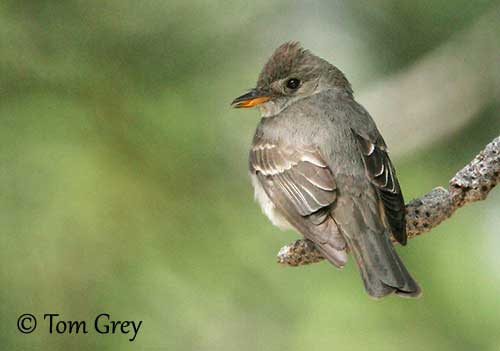
Male and female are similar, but the female is slightly smaller than the male.
The juvenile resembles adult but it has browner upperparts and slightly darker underparts. The wingbars are broader and buffy.
SUBSPECIES AND RANGE:
The Western Wood-Pewee has four subspecies.
C.s. saturatus breeds in SE Alaska and NW and W Canada, S in the USA to W Oregon. It winters in NW South America (probably mainly Colombia and Venezuela).
This race is darker and more olive above than nominate. The crown is blackish, throat and belly are yellower.
C.s. veliei breeds in E Alaska, S through interior, but mainly to N and C Mexico, E in the USA to N and W Great Basin states, and S to W Texas. It probably winters in W South America.
This one is greyer with little or no yellow tinge on the underparts.
C.s. peninsulae breeds in W Mexico (S Baja California). It probably winters in NW South America.
This race is paler with narrow grey breastband, broader edges on flight-feathers, shorter wings and tail and longer bill.
C.s. sordidulus (described above) breeds in the highlands of Mexico, S at least to Honduras, possibly to NC Nicaragua and Costa Rica. It winters S to Colombia, Ecuador and Peru.
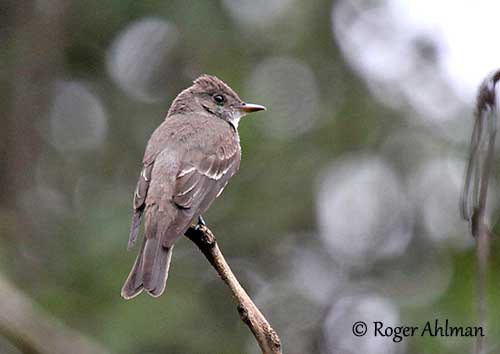
HABITAT:
The Western Wood-Pewee breeds in evergreen forest, coniferous forests, woodlands, and also open and closed canopy forests. During migration, is also occurs in treeless deserts.
During winter, it can be found in cultivated fields, meadows, grasslands, thickets, mature and secondary tropical forest, montane forest and forest borders.
The species is visible from sea-level to, at least, 3,000 metres of elevation, depending on the range.
CALLS AND SONGS: SOUNDS BY XENO-CANTO
The calls of the Western Wood-Pewee include a harsh, slightly descending “peeer”, also a “bzew” call probably given at night, a loud, infrequent “chip” given by both adults when alarmed, and whistled, rising “pewee” notes.
The song is given by the territorial male, a harsh, descending “pee-er” or “peweer” or “brreeu”. It is sometimes followed by rapid, rolled “chu-i-lit”.
The dawn song is a “tswee tee teet” also described as “pee-pip-pip-pip” interspersed with “pee-er” song. This song is mainly heard on the breeding grounds.
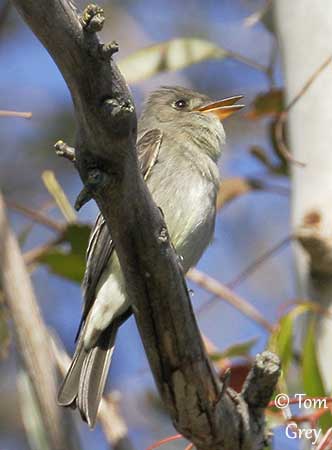
BEHAVIOUR IN THE WILD:
The Western Wood-Pewee feeds mainly on insects, and especially flying ones. The diet includes flies, wasps, bees, winged ants, moths, beetles and some caterpillars. But it also takes spiders, and occasionally a few berries.
It hunts from prominent perches. The bird often sits at the end of a dead branch for long periods, waiting for a passing prey. It flies out to catch it in the air, but it also may hover while gleaning insects from the vegetation, and sometimes from tall grass.
The small insects are eaten in flight, but the larger prey are brought back to the perch before to be eaten.
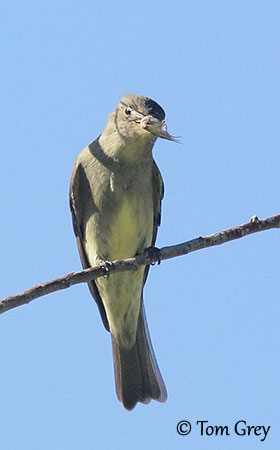
At the beginning of the breeding season, the male sings at dawn and dusk to defend the territory. Active chases through the treetops involving male and female are probably part of the courtship displays. The male also sings to attract a female. The species is monogamous for one season.
The Western Wood-Pewee migrates over medium to long distances to spend the winter in Central America. It leaves the breeding grounds in August-September and returns from mid-March to early June in Mexico, and by mid-April to late May in S USA (Texas). Vagrants are recorded in the E half of USA, and also from Cuba and Jamaica.
The Western Wood-Pewee has weak, fluttering flight with shallow wingbeats. When alighting, it quivers both wings and tail.
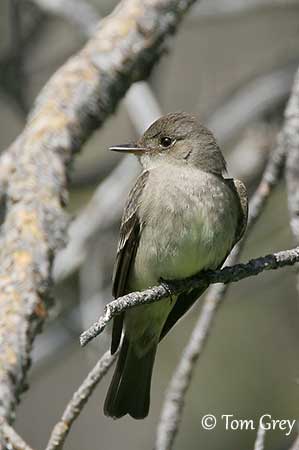
REPRODUCTION OF THIS SPECIES:
The breeding season takes place from early May to late August.
The female builds the nest in tree, often on horizontal branch or in small fork, well out from the trunk, between 5 and 12 metres above the ground, sometimes higher. The nest is an open cup made with grass, plant fibres and plant down. It is decorated outside with grey mosses, lichens and leaves. The cup is lined with softer grasses and feathers. Such nest may look like a bump or a knot on the branch.
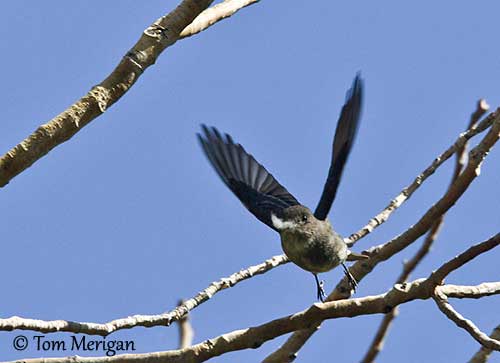
The female lays 2-4 white eggs with brown and lavender marks at large end. She incubates alone during 12-13 days. Both parents feed the chicks. The first flight occurs about 14-18 days after hatching.
Intruders such as squirrels and Western Scrub Jay are chased or attacked by the adults while calling and snapping their bills.
PROTECTION / THREATS / STATUS:
The Western Wood-Pewee is described as fairly common to uncommon throughout the wide range. The numbers declined by over 1% per year between 1966 and 2015. The global breeding population is estimated at 9,200,000 individuals (Partners in Flight).
The species is affected by logging and forest fires on the breeding grounds, whereas the loss of tropical forest on the wintering areas has a negative impact on the numbers. However, they may benefit from forest fragmentation in some areas.
The Western Wood-Pewee is not globally threatened and the species is currently evaluated as Least Concern.
